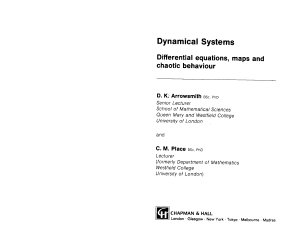Chapman & Hall, 1992. - 330 pages.
In recent years there has been unprecedented popular interest in the chaotic behavior of discrete dynamical systems. The ease with which a modest microcomputer can produce graphics of extraordinary complexity has fired the interest of mathematical-minded people from pupils in schools to postgraduate students. At undergraduate level, there is a need to give a basic account of the computed complexity within a recognized framework of mathematical theory. In producing this replacement for Ordinary Differential Equations) we have responded to this need by extending our treatment of the qualitative behavior of differential equations. This book is aimed at second and third year undergraduate students who have completed first courses in Calculus of Several Variables and Linear Algebra.
In recent years there has been unprecedented popular interest in the chaotic behavior of discrete dynamical systems. The ease with which a modest microcomputer can produce graphics of extraordinary complexity has fired the interest of mathematical-minded people from pupils in schools to postgraduate students. At undergraduate level, there is a need to give a basic account of the computed complexity within a recognized framework of mathematical theory. In producing this replacement for Ordinary Differential Equations) we have responded to this need by extending our treatment of the qualitative behavior of differential equations. This book is aimed at second and third year undergraduate students who have completed first courses in Calculus of Several Variables and Linear Algebra.

